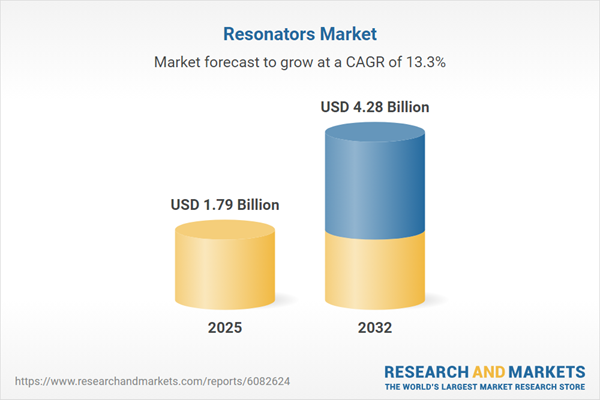Speak directly to the analyst to clarify any post sales queries you may have.
The resonators market is evolving rapidly as senior executives face increasing pressure to adapt procurement, technology, and supply chain strategies. As regulatory dynamics and new applications emerge, strategic leadership is essential to maintain competitiveness and manage complexity within this sector.
Market Snapshot: Resonators Market Size and Growth Trajectory
The resonators market is on a strong upward growth curve, with the market size expanding from USD 1.58 billion in 2024 to USD 1.79 billion in 2025. Projections indicate a further rise to USD 4.28 billion by 2032, resulting in a compound annual growth rate (CAGR) of 13.27%. This surge is driven by accelerated adoption in mission-critical sectors, including aerospace, automotive, telecommunications, healthcare, and industrial automation. Resonator technologies are integral to supporting robust frequency control and signal reliability in advanced systems. Industry innovation around miniaturization and integration into connected platforms forms the backbone of this expansion, highlighting the pivotal role that these components play in modern enterprise infrastructure.
Scope & Segmentation: Technology and Market Complexity
This resonators market research offers an in-depth analysis of critical market divisions, giving decision-makers the clarity needed for procurement and strategic planning:
- Type: Ceramic resonators, crystal resonators, MEMS-based resonators, and surface acoustic wave (SAW) devices—these facilitate performance across industry standards and are key for precise frequency control and energy efficiency.
- Application: Deployed in aerospace and defense (including avionics, satellites, radar), automotive (covering infotainment, telematics, and assistive technologies), consumer electronics (spanning wearables, smartphones, IoT devices, and televisions), healthcare (for imaging and patient monitoring), industrial automation (such as robotics and automated testing), and telecommunications (like 5G infrastructure and satellite connectivity).
- Frequency Range: Products serve frequency bands from sub-ten megahertz to beyond one hundred megahertz, enabling reliable performance for specialized system roles within a range of devices.
- Mounting Type: Chip scale package, surface mount, and through hole mounting—selected to fulfill design and assembly requirements of original equipment manufacturers (OEMs) and high-volume production operations.
- Sales Channel: Channels include authorized distributors, direct OEM procurement, and digital sales platforms, supporting international market reach and streamlined sourcing.
- Geographies: Market coverage spans the Americas, Europe, the Middle East, Africa, and Asia-Pacific, with a focus on regional demand drivers, supply logistics, and regulatory conditions shaping global procurement.
- Competitive Landscape: Company-level profiling highlights established manufacturers as well as emerging market entrants, offering visibility into innovation, partnerships, and expansion strategies.
Key Takeaways for Decision-Makers
- Device miniaturization in MEMS and SAW resonates with trends in mobile, IoT, and compact system design, directly impacting product roadmaps for OEMs and solution providers.
- Collaboration between semiconductor foundries and component specialists accelerates the co-development of tailored resonator modules for sector-specific needs.
- Environmental and operational sustainability is becoming central, with a shift toward lead-free ceramics and energy-efficient manufacturing across research, development, and procurement arenas.
- Diverse requirements among end-market verticals underline the importance of differentiated product strategies and specialized service support for procurement leaders.
- Senior executives must remain alert to evolving policy environments, given that regional regulatory shifts and tariff changes can alter sourcing strategies and risk management frameworks.
Tariff Impact on the Resonators Market
Recent and anticipated United States tariffs on resonator imports have elevated complexity for supply chains. Manufacturers and OEMs have responded by reassessing sourcing approaches and introducing regional or alternative production capacities. Strategies such as diversifying supplier bases, optimizing contract terms for balanced risk allocation, and deploying disciplined inventory management are strengthening operational resilience. Market leaders are also adopting technologies like MEMS resonators in telecommunications to strategically minimize exposure to tariffs and safeguard business continuity.
Methodology & Data Sources
This market research applies a mixed-methods approach, combining industry executive interviews, insights from engineers and supply chain experts, and secondary validation from regulatory and financial documentation. Data integrity is maintained through cross-verification with patent analytics, standards literature, and official company disclosures, ensuring reliability for each market segment.
Why This Report Matters
- Provides comprehensive insight into resonators market dynamics to support executive-level decisions for technology procurement and supply chain strategy.
- Enables benchmarking and adoption of best practices for market entry, innovation management, and sustainable sourcing across relevant regions.
- Gives practical knowledge on emerging materials, application-driven differentiation, and evolving product-market approaches to underpin product development and investment planning.
Conclusion
This research delivers focused analysis for senior leaders seeking to optimize market positioning, drive strategic partnerships, and enable operational growth as the resonators market continues to transform.
Table of Contents
3. Executive Summary
4. Market Overview
7. Cumulative Impact of Artificial Intelligence 2025
Companies Mentioned
The companies profiled in this Resonators market report include:- Murata Manufacturing Co., Ltd.
- TDK Corporation
- Seiko Epson Corporation
- Kyocera Corporation
- CTS Corporation
- Abracon LLC
- Fox Electronics Corporation
- TXC Corporation
- Rakon Limited
- SiTime Corporation
Table Information
| Report Attribute | Details |
|---|---|
| No. of Pages | 192 |
| Published | October 2025 |
| Forecast Period | 2025 - 2032 |
| Estimated Market Value ( USD | $ 1.79 Billion |
| Forecasted Market Value ( USD | $ 4.28 Billion |
| Compound Annual Growth Rate | 13.2% |
| Regions Covered | Global |
| No. of Companies Mentioned | 11 |









